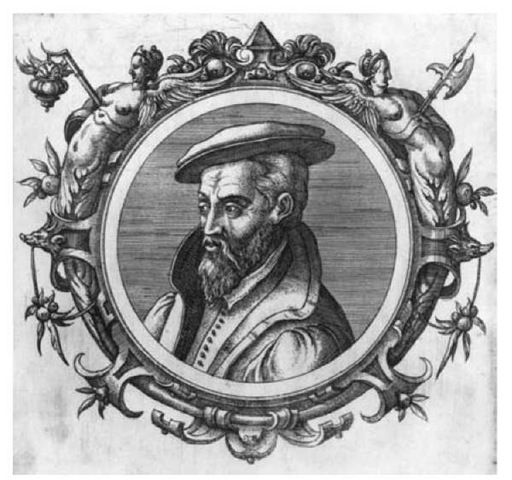Though his exhaustive knowledge of diverse subjects earned him the title "The Saxon Pliny," Georgius Agricola was best known as the author of De re metallica libri XII (On the Subject of Metals), a seminal text in the understanding of metallurgy and the mining and smelting processes of the time. Living in the mining capitals of St. Joachimsthal in Bohemia (Czechoslovakia) and Chemnitz, Germany, Agricola had extensive exposure to every aspect of mining, including the management of the mines and the machinery used, such as pumps, windmills, and water-wheels, which he incorporated into his books.
Born on March 24, 1494, in Glauchau, Saxony, to Gregor Bauer, a dyer and wool draper, Georg Bauer latinized his name to Georgius Agricola as was the custom at the time. His youngest and favorite brother followed his footsteps to Chemnitz in 1540 to become a metallurgist, and his oldest brother entered the priesthood in Zwickau and later in Glauchau. In 1526 Agricola married the widow of Thomas Meiner, the director of the Schneeberg mining district, and she died in 1541. In 1542 Agricola remarried, this time to Anna Schutz, the daughter of the guild master and smelter owner Ulrich Schutz, who entrusted his wife and children to Agricola’s care upon his death in 1534.
Georgius Agricola’s great knowledge of mining and metallurgy was commemorated by future president Herbert Hoover in 1912 when he prepared an English edition of Agricola’s masterwork, On the Subject of Metals.
In 1514, at the late age of 20, Agricola entered Leipzig University, earning his B.A. in 1515. The university retained him as a lecturer in elementary Greek for the next year, after which Agricola went to Zwickau where he organized a new Schola Graeca in 1519 and wrote his first book in 1520, De prima ac simplici institutione grammatica, which described new humanistic methods of teaching. Agricola then fled from the radicalism of the Reformation back to Leipzig, where he studied medicine between 1523 and 1526. During this time, he served on the editorial board in Bologna and Venice for the Aldina editions of texts by Galen and Hippocrates, interests he maintained later in life. After earning his M.D., he left Italy via the mining districts of Carinthia, Styria, and the Tyrol bound for Germany, where he stayed briefly until the mining city of St. Joachimsthal elected him town physician and apothecary in 1527.
In 1534 Agricola departed for Chemnitz, yet another city renowned for its mining, which elected him burgomaster, or mayor, in 1545. The combination of chronically sick miners and heavy metals allowed Agricola to investigate the pharmaceutical uses of minerals. Agricola published on a wide range of topics, including politics and economics. In 1554 he published De peste libri III, based on his experiences administering to sufferers of the black plague that swept through Saxony between 1552 and 1553.
De re metallica libri XII (On the subject of metals), his crowning achievement, did not appear until 1556, four months after his death. The text surveyed all aspects of mining at the time, from working conditions to metallurgy to smelting processes. Agricola had finished writing it during his return visit to St. Joachims-thal, where he had started drafting it 20 years earlier. While there, he met designer Blasius Weffring, who spent the next three years creating 292 woodcuts to illustrate the text. A year later Phillipus Bech translated the work into Old German but retained the woodcuts, creating an edition so fine that it survived 101 years in seven editions.
Agricola died on November 21, 1555, in Chemnitz. Mining engineer and future U.S. president Herbert Hoover revived Agricola’s legacy by preparing an English edition of his masterwork, On the Subject of Metals, in 1912, a testament to the primacy of Agricola’s work.

